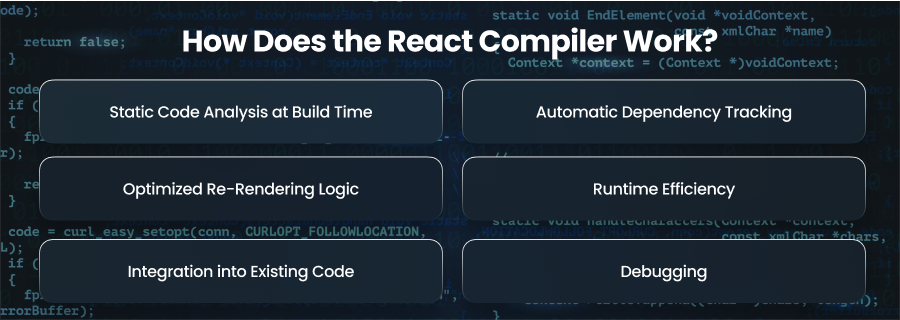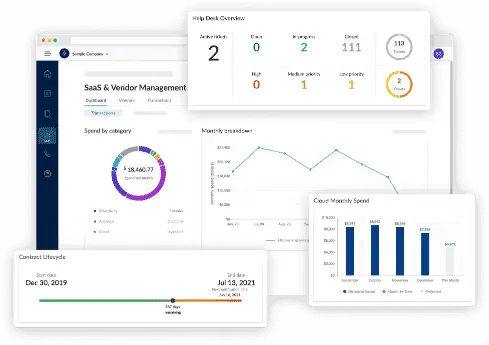According to eSparkBiz, React has a global market share of 5.9% of the JavaScript libraries. Therefore, it’s still an absolute favorite. This is because React’s developer friendly environment and performance make it a popular choice for creating user interfaces. But as systems become more complex, developers often run across performance problems that require careful optimization.
To cut down on pointless renderings, React developers had to use strategies like memoization and component tree reorganization until recently. Although these tactics are effective, they need human involvement and may overburden codebases with boilerplate pertaining to efficiency.
This is where React Compiler can help. By automating a lot of the operations that developers presently conduct by hand, it claims to make speed optimization simpler.
We’ll go over the React Compiler’s definition, internal operations, and how developers may be ready to use it in this article.
What is the React Compiler?

The React Compiler is a new optimization engine designed to make React applications faster and more efficient by automatically applying performance improvements at build time. Instead of relying on React developers to manually sprinkle optimization, such as React.memo, useCallback, or useMemo, the compiler does this automatically. This ensures applications run smoothly with minimal developer intervention.
Additionally, the React Compiler functions as a tool for static analysis and manipulation. It examines your React components, evaluates their usage of context and props, and then optimizes them to cut down on pointless calculations. Your code is already performance-optimized by the time it reaches runtime, since this process occurs during compilation.
For example, think of a part that receives props but seldom changes. Even if its props don’t change, this component will often re-render if it is a part of a parent that does so regularly. To remedy this, developers would wrap it with React.memo.
With the React Compiler, however, this optimization happens automatically. The compiler analyzes the component and ensures it only re-renders when its props actually change.
Why Use A React Compiler?

Eliminating the Burden of Manual Optimization
React.memo and useCallback are two features that developers must continually use in conventional React programming to cut down on pointless renderings and costly recalculations. Despite their strength, these hooks have a large cognitive overhead. Additionally, by implementing these optimizations automatically, the React Compiler removes this load. Developers may now concentrate on creating features and enhancing user experience rather than micromanaging performance.
Achieving Consistency Across Codebases
Different developers frequently use different manual optimization techniques. There are teams who employ memorization significantly and those that use it rarely. This disparity might lead to unpredictable bottlenecks and uneven performance. Optimizations are implemented uniformly and continuously throughout an application when using the React Compiler. Also, teams no longer have to worry about individual coding styles introducing performance gaps, leading to a more reliable and maintainable codebase.
Reducing Boilerplate
React applications can become cluttered with performance-related boilerplate code. Wrapping components with React.memo or maintaining complex dependency arrays adds noise that detracts from readability. The React Compiler reduces this clatter by embedding optimizations directly during compilation. Cleaner, more declarative code that is easier to comprehend and scale without compromising speed is the end result.
Improving Performance
For small projects, performance optimizations might not feel critical. However, in enterprise level applications with thousands of components and frequent state updates. Also, the React Compiler ensures only the components that actually need to update are re-rendered and boosting runtime efficiency.
Minimizing Human Error
Even experienced developers can misapply memoization or forget to optimize critical components. A misplaced dependency array in useEffect or an overlooked React.memo wrapper can introduce subtle bugs or performance regressions. The React Compiler reduces the risk of such human errors by analyzing component dependencies systematically and applying optimizations where they are truly needed. Hence, this ensures performance gains are consistent and less prone to developer mistakes.
Features of React Compiler

Automatic Memoization
One of the best features of the React Compiler is its ability to apply memoization automatically. To avoid needless re-renders, developers typically utilize React.memo or useMemo. This calls for manually determining which parts or operations need to be memoized, followed by the implementation of such optimizations.
With the compiler, this process becomes invisible. After examining each component’s dependencies, the compiler decides if re rendering is required. If it finds that the props or state of the component haven’t changed, it skips the re render, saving developers from having to explicitly encapsulate a component. This ensures that codebase optimizations are applied consistently.
Static Analysis of Components
The React Compiler uses static analysis to study your components at build time. Moreover, it inspects how props and context are used within a component, then applies optimizations based on this understanding. As a result, before the program ever launches in the browser, the compiler may remove pointless calculations and re-renders.
Additionally, static analysis guarantees that the compiler only implements safe optimizations. The compiler can take this into consideration and prevent erroneous assumptions, for instance, if a component has side effects or depends on outside variables.
Compatibility With Existing Codebases
The React Compiler is intended to function easily with existing React code, despite the common worry that adopting new tools may damage current apps. To utilize the compiler, developers do not have to redesign their applications or rearrange their component trees.
Whether components require third-party libraries or hooks, it optimizes them and integrates into the construction process. This ensures that teams can adopt the compiler incrementally without disrupting ongoing projects.
Improved Runtime Performance
React Compiler has the ability to deliver noticeable runtime performance improvements. Therefore, the compiler lowers reconciliation cost and maintains a lean virtual DOM by reducing the number of pointless re-renders and making sure that only the appropriate components update when required.
These changes result in reduced CPU utilization and more seamless scalability for large-scale applications.
Cleaner Developer Experience
Boilerplate code and a distraction from features are common outcomes of React speed improvement. The React Compiler improves the developer experience by removing the need for manual optimizations and streamlining the code.
You may depend on the compiler to optimize a component rather than thinking about whether it should be declarative or memoized. In addition to producing cleaner code, this lessens the possibility of issues brought on by improper or excessively employed performance hooks.
Consistency Across Teams
Different coding styles and optimization techniques are common in big development teams. Some developers are diligent about utilizing useMemo and useCallback, while others may omit them totally. Regardless of code style, the React Compiler guarantees uniform optimization.
Hence, teams benefit from predictable performance improvements without having to enforce strict optimization guidelines manually.
How Does the React Compiler Work?

Static Code Analysis at Build Time
The process starts at build time, where the compiler examines the React components in your projects. Moreover, it performs static code analysis to understand how each component works, what props it consumes and whether it depends on context or external variables.
The compiler can determine where re-renders can be avoided thanks to this analysis. For instance, the compiler may make sure that modifications to unrelated props won’t result in a re-render if a component only utilizes a particular subset of props.
In other words, it creates a map of dependencies for every component and determines the minimal conditions under which the component should update.
Automatic Dependency Tracking
Traditionally, developers manage dependencies manually through useMemo and dependency arrays in hooks. The React Compiler replaces this with automatic dependency tracking.
By understanding which variables and props a component depends on, the compiler can decide whether a re render is necessary, without requiring explicit instructions from the developer.
This eliminates the common issue of incorrect dependency arrays. Also, the compiler ensures that dependency management is both accurate and efficient.
Optimized Re-Rendering Logic
The compiler creates efficient code after mapping dependencies, guaranteeing that only parts that actually require re-rendering will do so. Additionally, this eliminates the need for other memoization methods like React.memo.
For instance, the child won’t re-render if a parent component is altered but the child isn’t reliant on the new data. Runtime rendering is accelerated as a result of a lighter virtual DOM and less unnecessary diffing.
In essence, the compiler adds intelligent rendering logic to your program that is similar to what a knowledgeable developer would do, but it is done globally and automatically.
Runtime Efficiency
The result of these optimization is visible at runtime. Because fewer components re-render, the reconciliation process in React becomes much faster. CPU use dramatically decreases and pages feel more snappy, particularly in big apps with intricate state management.
The compiler guarantees accuracy in addition to performance optimization. Because of its careful optimization, the user interface is constantly in sync with the underlying data. Developers get both safety and performance, without the extra mental overhead.
Integration into Existing Code
The fact that the React Compiler doesn’t need developers to alter their React code is among its most significant features. You don’t have to rearrange your components or learn new APIs.
The compiler integrates into the build pipeline, typically through existing tools like Babel, and applies optimization automatically. From the standpoint of the developer, the application functions similarly, although more quickly and effectively.
Debugging
The compiler is meant to be transparent to developers even if it operates in the background. When optimizations are used, they don’t cause unexpected behavior or obstruct debugging.
What’s Ahead for React Compiler?

Wider Adoption in the React Ecosystem
At the moment, the React compiler is gradually being rolled out and tested across projects of different sizes. As stability improves, we can expect wider adoption among developers and libraries.
Frameworks like Next can integrate the compiler directly into their build pipelines, making optimization seamless for developers who already rely on these ecosystems. Also, in the near future, having the compiler enabled by default in popular tools could become the norm rather than the exception.
Enhanced Developer Tooling
Although the compiler already functions in the background, the React team is striving to improve developer tools. This entails providing developers with information about what the compiler is optimizing and any trouble spots.
Imagine being able to clearly observe which components were optimized by the compiler and how it affected rendering when you open React DevTools.
Smarter Optimizations Over Time
Currently, the React Compiler focuses primarily on automating memoization and dependency tracking. But the long term vision includes smarter and more diverse optimizations. These could involve:
- Detecting unnecessary computations and precomputing values at build time.
- Optimizing common patterns in data fetching or state management.
- Dynamically choosing the most efficient reconciliation strategy depending on the app’s size and complexity.
Improved Integration with Concurrent React
React’s Concurrent Mode represents a shift toward making apps more fluid and responsive. The React Compiler could play a significant role in making concurrency smarter by ensuring that only the most critical components update in real time, while background updates remain efficient.
Hence, this means smoother user experiences in apps with complex UIs or real time dashboards.
Ecosystem and Third Party Libraries
Another exciting area of growth is ecosystem integration. Many third party React libraries, from UI kits to state management tools, require developers to optimize components manually to avoid unnecessary renders.
Final Words
The React Compiler automates performance optimization while simplifying code. With features like automatic memoization and static analysis, it ensures faster and more efficient apps. Moreover, as adoption grows, it promises to reshape the ecosystem, making React development smarter and more scalable.



















